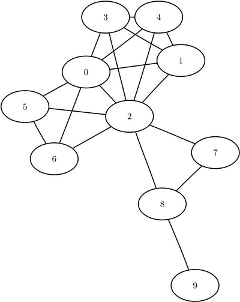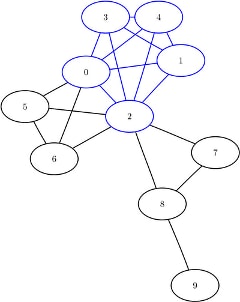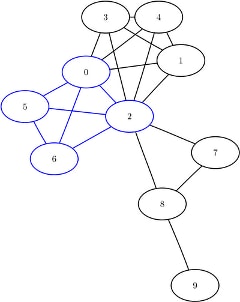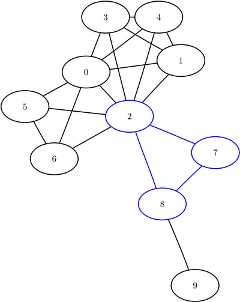The OPTNET Procedure
- Overview
-
Getting Started

-
Syntax
 Functional SummaryPROC OPTNET StatementBICONCOMP StatementCLIQUE StatementCONCOMP StatementCYCLE StatementDATA_ADJ_MATRIX_VAR StatementDATA_LINKS_VAR StatementDATA_MATRIX_VAR StatementDATA_NODES_VAR StatementLINEAR_ASSIGNMENT StatementMINCOSTFLOW StatementMINCUT StatementMINSPANTREE StatementSHORTPATH StatementTRANSITIVE_CLOSURE StatementTSP Statement
Functional SummaryPROC OPTNET StatementBICONCOMP StatementCLIQUE StatementCONCOMP StatementCYCLE StatementDATA_ADJ_MATRIX_VAR StatementDATA_LINKS_VAR StatementDATA_MATRIX_VAR StatementDATA_NODES_VAR StatementLINEAR_ASSIGNMENT StatementMINCOSTFLOW StatementMINCUT StatementMINSPANTREE StatementSHORTPATH StatementTRANSITIVE_CLOSURE StatementTSP Statement -
Details

-
Examples
 Articulation Points in a Terrorist NetworkCycle Detection for Kidney Donor ExchangeLinear Assignment Problem for Minimizing Swim TimesLinear Assignment Problem, Sparse Format versus Dense FormatMinimum Spanning Tree for Computer Network TopologyTransitive Closure for Identification of Circular Dependencies in a Bug Tracking SystemTraveling Salesman Tour through US Capital Cities
Articulation Points in a Terrorist NetworkCycle Detection for Kidney Donor ExchangeLinear Assignment Problem for Minimizing Swim TimesLinear Assignment Problem, Sparse Format versus Dense FormatMinimum Spanning Tree for Computer Network TopologyTransitive Closure for Identification of Circular Dependencies in a Bug Tracking SystemTraveling Salesman Tour through US Capital Cities - References
Clique
A clique of a graph ![]() is an induced subgraph that is a complete graph. Every node in a clique is connected to every other node in that clique.
A maximal clique is a clique that is not a subset of the nodes of any larger clique. That is, it is a set
is an induced subgraph that is a complete graph. Every node in a clique is connected to every other node in that clique.
A maximal clique is a clique that is not a subset of the nodes of any larger clique. That is, it is a set ![]() of nodes such that every pair of nodes in
of nodes such that every pair of nodes in ![]() is connected by a link and every node not in
is connected by a link and every node not in ![]() is missing a link to at least one node in
is missing a link to at least one node in ![]() . The number of maximal cliques in a given graph can be very large and can grow exponentially with every node added. Finding
cliques in graphs has applications in numerous industries including bioinformatics, social networks, electrical engineering,
and chemistry.
. The number of maximal cliques in a given graph can be very large and can grow exponentially with every node added. Finding
cliques in graphs has applications in numerous industries including bioinformatics, social networks, electrical engineering,
and chemistry.
You can find the maximal cliques of an input graph by invoking the CLIQUE statement. The options for this statement are described in the section CLIQUE Statement. This algorithm works only with undirected graphs.
The results for the clique algorithm are written to the output data set that is specified in the OUT= option in the CLIQUE
statement. Each node of each clique is listed in the output data set along with the variable clique to identify the clique to which it belongs. A node can appear multiple times in this data set if it belongs to multiple cliques.
The clique algorithm reports status information in a macro variable called _OROPTNET_CLIQUE_. See the section Macro Variable _OROPTNET_CLIQUE_ for more information about this macro variable.
The algorithm used by PROC OPTNET to compute maximal cliques is a variant of the Bron-Kerbosch algorithm (Bron and Kerbosch, 1973; Harley, 2003). Enumerating all maximal cliques is NP-hard, so this algorithm typically does not scale to very large graphs.
Maximal Cliques of a Simple Undirected Graph
This section illustrates the use of the clique algorithm on the simple undirected graph ![]() shown in Figure 2.15.
shown in Figure 2.15.
Figure 2.15: A Simple Undirected Graph ![]()

The undirected graph ![]() can be represented by the links data set
can be represented by the links data set LinkSetIn as follows:
data LinkSetIn; input from to @@; datalines; 0 1 0 2 0 3 0 4 0 5 0 6 1 2 1 3 1 4 2 3 2 4 2 5 2 6 2 7 2 8 3 4 5 6 7 8 8 9 ;
The following statements calculate the maximal cliques, output the results in the data set Cliques, and use the SQL procedure as a convenient way to create a table CliqueSizes of clique sizes:
proc optnet
data_links = LinkSetIn;
clique
out = Cliques;
run;
proc sql;
create table CliqueSizes as
select clique, count(*) as size
from Cliques
group by clique
order by size desc;
quit;
The data set Cliques now contains the maximal cliques of the input graph; it is shown in Figure 2.16.
Figure 2.16: Maximal Cliques of a Simple Undirected Graph
| clique | node |
|---|---|
| 1 | 0 |
| 1 | 2 |
| 1 | 1 |
| 1 | 3 |
| 1 | 4 |
| 2 | 0 |
| 2 | 2 |
| 2 | 5 |
| 2 | 6 |
| 3 | 2 |
| 3 | 8 |
| 3 | 7 |
| 4 | 8 |
| 4 | 9 |
In addition, the data set CliqueSizes contains the number of nodes in each clique; it is shown in Figure 2.17.
Figure 2.17: Sizes of Maximal Cliques of a Simple Undirected Graph
| clique | size |
|---|---|
| 1 | 5 |
| 2 | 4 |
| 3 | 3 |
| 4 | 2 |
The maximal cliques are shown graphically in Figure 2.18 and Figure 2.19.
Figure 2.18: Maximal Cliques ![]() and
and ![]()
|
|
|
|
|
|
|
|
|
Figure 2.19: Maximal Cliques ![]() and
and ![]()
|
|
|
|
|
|
|
|
|



